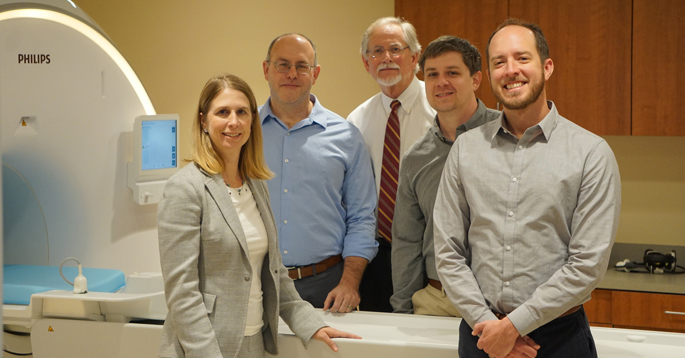
Researchers with the Vanderbilt Diabetes Research and Training Center (DRTC) have discovered a progressive decline in pancreas volume over a one-year period in children and adolescents with newly diagnosed Type 1 diabetes.
The Vanderbilt report is the first to examine pancreas volume both prior to and at the time of diabetes diagnosis and to track pancreas volume over time. Previous research had shown that individuals with Type 1 diabetes of a long duration had a smaller pancreas. The new findings were recently published in the American Diabetes Association’s journal Diabetes Care.
In the study, Vanderbilt investigators measured pancreas size in more than 50 children and adolescents with newly diagnosed Type 1 diabetes and compared this measure to pancreas size in age-matched individuals without Type 1 diabetes. Measurements were obtained by non-contrast magnetic resonance imaging (MRI) scans taken at the Vanderbilt University Institute of Imaging Science (VUIIS) approximately six months apart.
Using the MRI-derived information, the investigators calculated the pancreas volume and found that smaller pancreas volume was evident within 100 days of diagnosis of Type 1 diabetes, and pancreas volume continued to decline over the first year after diabetes diagnosis. Individuals with Type 1 diabetes had an average pancreas volume nearly 40% less than those without Type 1 diabetes.
“The endocrine portion of the pancreas, the part that releases insulin and other hormones, makes up only 1 to 2% of the pancreas,” said Jon Williams, PhD, clinical research coordinator for the study.
“Most of the pancreas is exocrine tissue that releases enzymes into the intestine for food digestion, so the loss of insulin-producing islet cells cannot explain the reduced pancreatic volume. The decline in pancreas volume in individuals with Type 1 diabetes indicates that changes occur in both the endocrine and exocrine portions of the pancreas, which is surprising since Type 1 diabetes was thought to only affect the insulin-producing cells.”
The study team also collaborated with TrialNet, a NIH-funded research network that investigates how Type 1 diabetes can be prevented in first-degree relatives of people with the disease.
TrialNet screening looks for diabetes-related autoantibodies that signal increased risk of developing Type 1 diabetes.
The screening can detect these autoantibodies up to 10 years before diagnosis, and the presence of two or more of the autoantibodies indicates a high risk of disease development.
More than 20 individuals identified by the Vanderbilt TrialNet Center, headed by William Russell, MD, director of Pediatric Endocrinology, as being at high risk for developing Type 1 diabetes were enrolled in the study to look for possible changes in the pancreas prior to the onset of diabetes.
“We certainly don’t want to see anyone get diabetes, of course, but we are scanning the pancreas in individuals with these autoantibodies prior to the development of diabetes so we can more directly examine the temporal nature of this change in the pancreas,” Williams said.
Other investigators included former Vanderbilt University faculty member Jack Virostko, PhD, now at the Dell Medical School Department of Diagnostic Medicine at the University of Texas at Austin; Daniel Moore, MD, PhD, assistant professor of Pediatrics and an investigator in the Vanderbilt TrialNet Center; Melissa Hilmes, MD, assistant professor of Radiology; and DRTC Director Alvin C. Powers, MD. Hilmes interpreted the more than 300 MRI scans conducted during the study.
A new multisite investigation funded by a $1.5 million, three-year JDRF grant is beginning this month to extend the study’s findings and establish protocols for the use of MRI technology beyond Vanderbilt and for future multicenter trials in Type 1 diabetes. Powers and Virostko are the study’s co-principal investigators.
This new phase of the investigation includes researchers from Vanderbilt University Medical Center, University of Texas at Austin, the Barbara Davis Center for Diabetes at the University of Colorado, University of Chicago and St. Vincent’s Medical Research Institute at the University of Melbourne.
“It’s critical that we more clearly understand the dynamics of these changes in the pancreas and what they mean for the pathogenesis of Type 1 diabetes,” Powers said.
“This new discovery was the result of synergistic collaboration between the outstanding Vanderbilt pediatric diabetes program, the VUIIS, and the DRTC.”
“I’ve been updating the families on our findings, and they know they’re a part of an exciting study that is changing our understanding of Type 1 diabetes,” Williams said. “The eagerness of the kids to participate has been great, and we wouldn’t have this important study if it wasn’t for the families’ commitment to continue to come in for these repeat scans. They deserve most of the credit.”
JDRF, which supported this study, is the leading global organization funding Type 1 diabetes research.












